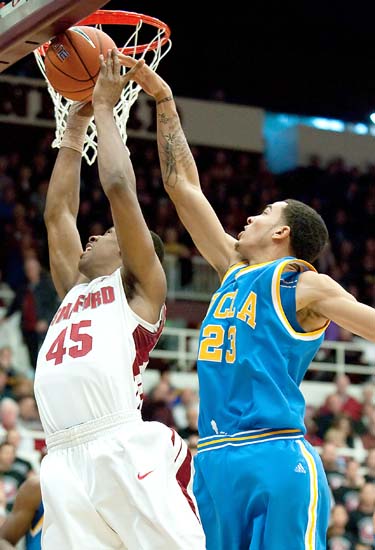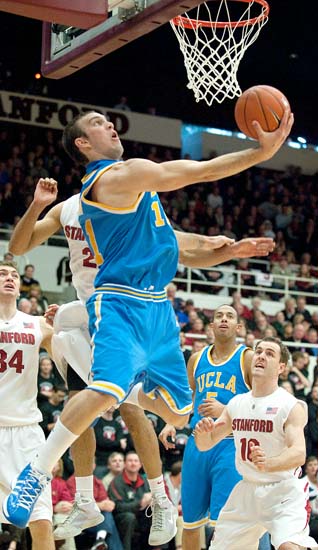
Though they employ very different styles, UCLA’s two youngest players are making a name for themselves on the glass.
One is a force to be reckoned with in the lane, powering through opponents to create an opening the size of a single large frame and a 29.5-inch orange ball.
The other is a flash of blue and white, appearing under the basket only briefly, but long enough to suck the ball into his body with arms like vacuum cleaners.
The first is freshman center Reeves Nelson. At just 18 years old, he has the body and the knack for this key aspect of the game.
Before the season started, some curious media members had gathered around the six-foot-eight newcomer, who was supposedly grabbing the most boards in practice ““ more than team mainstays like senior James Keefe and sophomore Drew Gordon.
Was he surprised at the statistic?
“No, because it’s what I do,” Nelson said calmly.
The second is freshman forward Tyler Honeycutt. The Los Angeles native missed much of summer training with a back injury and then was forced to sit the first six games of the season with a stress reaction in his right tibia, but he’s been most efficient in his return.
Honeycutt is leading the team in rebounds through the first four games of conference play, averaging 6.8 per game.
Before the latest road trip, Ben Howland made a plea to his team.
“We’ve got to do a better job collectively rebounding to have a chance to win,” the UCLA coach said.
There have been plenty of these appeals this year from Bruin coaches and fans alike, but with Gordon’s midseason transfer, rebounds were certainly going to be at a premium during the Pac-10 schedule.
Fortunately for Howland and Co., the team’s two most recent additions to the starting lineup have stepped up. Either Honeycutt or Nelson has at least shared the team lead in rebounds for nine of the Bruins’ last eleven games.
Neither player began the season as a starter, but each was moved to the starting five right before one of the Bruins’ big matchups. And neither of them disappointed in their debuts.
Nelson went toe-to-toe with preseason All-American candidate Cole Aldrich of Kansas in December, totaling six offensive rebounds and two steals in just 23 minutes.
That game also cemented his status as a fan-favorite with the Pauley Pavilion crowd when he returned to the game wearing protective goggles after being knocked out of the game with a shot to the eye.
Honeycutt’s first start for UCLA was last week against California, his first time playing on the road in a Pac-10 game.
As the game’s only double-digit rebounder, his play that night was critical in sending the Haas Pavilion crowd of more than 10,000 home disappointed with their team’s one-point loss to the Bruins in overtime.
Howland likes Honeycutt’s technique, but of course he is always looking for his players to fine-tune their game.
“Tyler’s a very good rebounder,” Howland said. “He goes and gets it with two hands. He’s quick to the ball.
“But there are also times where he’s getting blocked out and he could be an even better rebounder.”
Naturally, Howland added, they would be working on box-out drills this week in practice. Honeycutt has yet to really make a solid impact on the offensive end of the court though, choosing the pass much more often than the shot. In fact, he’s only put up 11 attempts in conference play, despite his increased playing time.
Honeycutt attributes some of this offensive timidity to just not getting in enough repetition during the summer when he was largely inactive.
“There’s a lot of stuff I could have been doing in the offseason, (like) shooting, a lot of shooting,” he said.
He regrets that during that time he was not able to play in the summer pickup games at the Student Activities Center, which have become famous for attracting NBA stars who compete with current and former Bruin players.
Howland has noticed Honeycutt’s work ethic and has faith that the freshman has much potential to grow while at UCLA.
“He really wants to be a good player and he’s willing to spend the time in the gym,” Howland said.
After seeing the size of some of the players he has faced this season, Honeycutt also wants to finally get around to spending some time in the weight room.
“A lot of the guards I play are six-five, six-six, but they weigh 215, 220,” said Honeycutt, who said that he’s 190 lbs. now, but is listed at 178 in the team’s media guide.
“Next year it’ll be different,” he added.
Improvement seems to be the name of the game for the Bruins after such a poor start to the season, and the individual development of the team’s top freshman will be essential to fulfilling that philosophy.
“There’s a lot of learning that’s going on with these kids playing at this level for the first time,” Howland said. “From high school to this level is a big jump.”
If their statistics continue to improve, however, the Bruins may be able to make a similar leap in their performance.
